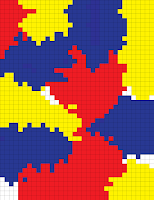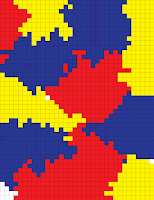My system is based on a very simple, yet dynamic series of rules. When thinking about what type of system I wanted to portray, I knew I wanted it to involve randomness and probability; I wanted the system to have a different outcome each time even if the exact same rules were followed by everyone with the same assumptions.
I started by placing rectangular blocks of the three primary colors in random locations on the graph paper. Each page after that, the blocks attempted to 'expand' by filling in the spaces next to them (horizontally and vertically) with their color. However, each color was not guaranteed that it would 'take over' the adjacent blocks; the colors were assigned a probabilities as to whether they would succeed.
The probabilities were assigned at random, based on my preferences.
page 1
Any color vs. White (85% chance of take over)
Blue vs. Red (55% chance of take over)
Blue vs. Yellow (75% chance of take over)
Red vs. Yellow (60% chance of take over)
From these probabilities we would expect to see easy expansion by the colors until they ran into one another. Once this occurred, we would see yellow lose ground pretty steadily to both red and blue; we would also expect to see blue slowly advance into red's territory. However, none of these outcomes are guaranteed as all expansion is left up to chance.
To determine each individual outcome I used a random number generator (link), with limits of 1 and 100. If the number generated was less than or equal to the percentage assigned, the color would expand; if not, the other color would succeed (*not applicable to white). The process of determining each outcome was long and tedious, however, I like the outcome.
page 2
page 3
page 4
page 5
page 6
Hopefully I did not make this sound too complicated and its easy to follow.
Heres a short video of the progression:










No comments:
Post a Comment